

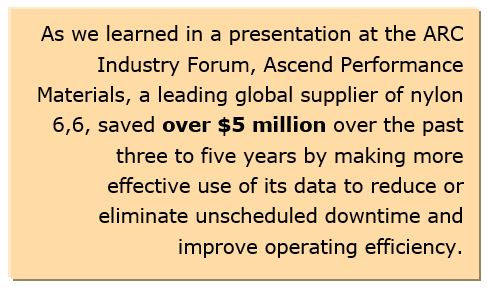
Ascend Performance Materials’ strategic vision is to be the most reliable, creative, and responsible supplier of the above products. The vision includes assuring customers of an uninterrupted supply of high-quality products, while making a difference in the lives of its employees and the communities in which the company operates.
In his recent ARC Forum presentation and subsequent discussions with ARC, Terry Unruh, Production & Maintenance Process Leader at Ascend Performance Materials explained the company’s operations prior to implementing its internal “Mobility” and “Visual Factory” projects. This uses Wonderware mobility and operational intelligence solutions from Schneider Electric.
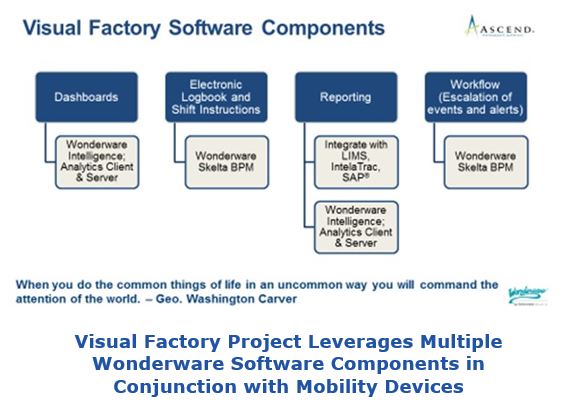
Ascend leadership determined that the company needed to start thinking “out of the box” and use its data to become more efficient, identify trends, fix problems faster, and continuously improve processes. “We needed to be able to get the data into the hands of the supervisors, engineers, and operators right away,” stated Mr. Unruh. The company began numerous continuous improvement initiatives. One of these was to implement mobile devices to obtain operational and maintenance field data. Success here led to further integration of data using plant intelligence software. This allowed employees get to the data they needed faster and more conveniently.
Ascend looked at different software solutions along with different tablets, smartphones, and other mobile devices that it could use to help field operators and maintenance people complete tasks and procedures along with dashboards for supervisors, managers, and field personnel. The company ultimately chose Wonderware’s IntelaTrac software for field mobility and Wonderware Plant Intelligence software for the control room and management suite.
According to Mr. Unruh, the company can now solve problems faster. IntelaTrac e-mails messages to supervisors and staff on an efficient exception basis. Therefore supervisors, engineers, operators, and maintenance technicians can take actions based on that information.
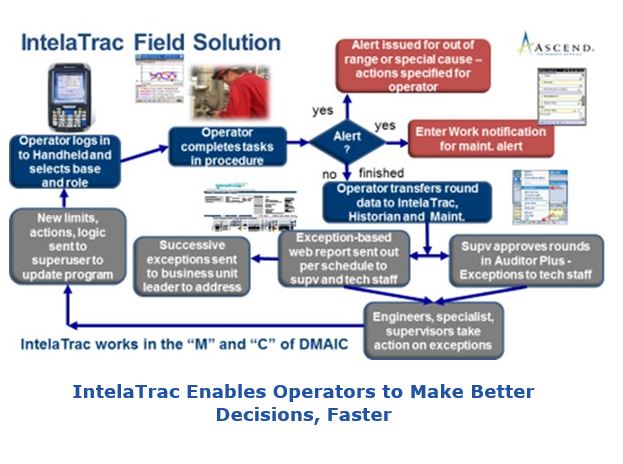
The air compressor had just been overhauled. Through an oil analysis, it was discovered that the wrong oil had been added, which resulted in the high pressure alert. Without the mobility and alerts, it was likely that the gear box would have failed at a cost of $30,000 to replace, along with the substantial costs associated with unplanned downtime.
The software and mobility solution now help the company keep information in the forefront and better understand the process. In general, any exceptions that happen repeatedly are sent to management to review and address. According to Mr. Unruh, “We use the DMAIC [Define, Measure Analyze, Improve and Control] continuous improvement process to improve and optimize our processes and design.”
The new reports improve workforce engagement. Now, material and equipment are tracked using RFIDs and bar codes. In morning meetings, workers use the exception reports to help answer questions such as, “What were the exceptions last night?” and “What’s happening now?” By using mobility to make the data more accessible to operations, Ascend achieved significant value.
The solution’s graphic displays help enhance operator knowledge to enable them to take appropriate corrective action. Mr. Unruh told us that the workers can now see the big picture, which reinforces the company’s continuous improvement culture. Using models, the company created a dashboard to determine when the process is getting off course. It graphically enhances the worker’s knowledge with better intelligence.
Ascend worked with Schneider Electric and operators to add new dashboards. The operators wanted electronic logbooks, shift instructions and reports that included up-to-date information that was easy to find and view. They did not want to have to go back and sift through papers or data. Ascend selected Wonderware Intelligence, Analytics, Client & Server for the dashboards and reporting, Wonderware Skelta BPM for the electronic logbook, shift instructions, workflow, and alerts. The company also integrated with LIMS and other field devices using IntelaTrac and SAP for reporting and business information. Ascend integrated automation systems, LIMS, quality measures, energy measures and production schedules (e.g. railcar shipments), and places the intelligence in operator’s hands via IntelaTrac and Intelligence.
The main dashboard allows operators to see operational KPIs and metrics, providing the ability to quickly view and understand what is happening. The information on the dashboards is integrated from LIMS, historian, SAP and IntelaTrac and includes intelligence on safety, environment, quality, production, reliability, and energy. The visualization includes role-based trends, bar graphs, and dashboards for operators, enabling them to improve control and better 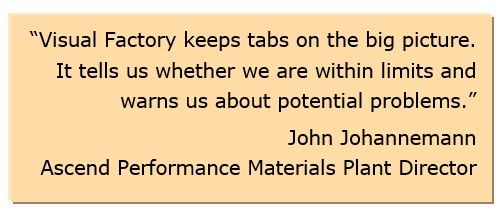
Mr. Unruh illustrated this with a simulated dashboard of the typical areas that the company might track. According to Mr. Unruh, the company typically includes data related to safety, environmental statistics, production, reliability, OEE, energy yield, etc. In the dashboards, if the top header turns red, it’s indicating a potential problem and the operator can drill down to the next level and might also plot the relevant information. The dashboard also includes vertical bars that indicate target ranges.
Since operators rotate positions in a plant and operations change, the operator dashboards include daily instructions that help align goals. This replaces paper instructions and ad hoc updates of target and limits to make it easier to find the needed documents and bridge gaps in understanding. Operators have the data to better understand what to do to 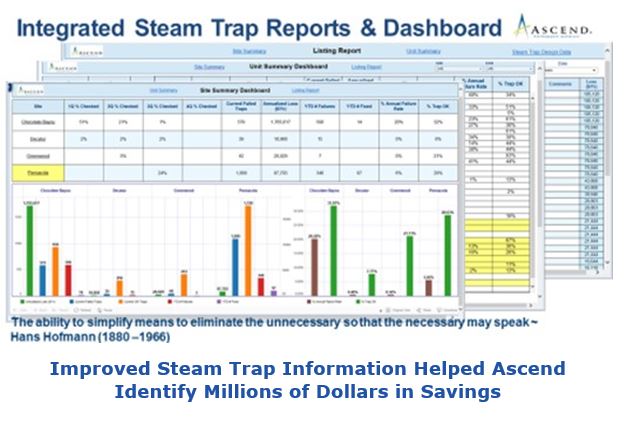
In addition, Ascend has added electronic log books for comments, pictures and documents. This provides a searchable database for historical operations data. Prior to this an operator or specialist had to comb through numerous paper log books to find operations information.
For example, the company has over 10,000 steam traps. During steam trap rounds, operators use IntelaTrac to enter the trap condition information. That data goes into the Intelligence system and is combined with a steam trap database that results in a dollar value for malfunctioning trap. The steam trap dashboard allows drill down from plant- to unit-specific summaries. Plant personnel were able to use this information to equate the type of steam trap, orifice size and service used to financial value. The company realized approximately $2 million in steam savings and has identified even more opportunities.
The company also used this type of information to avoid several plant shutdowns due to inoperable spare equipment, saving it over $2 million. In addition, Mr. Unruh believes the company is reducing reactive work by using the asset-related intelligence to be more proactive for maintenance.
Mr. Unruh emphasized, “Culture is very important to consider on this journey. Operators need to be involved and buy in to the solution.” Even with the improved visualization and ease-of-use features, the new software changes would not have succeeded well without getting operator buy-in and understanding their specific data needs.
Ascend Performance Materials saved approximately $5 million in energy and utilities, including costs from steam traps, vertical pump issues, operating efficiency and so on by improving operational intelligence. Ascend chose Wonderware IntelaTrac mobility solutions and Wonderware plant intelligence software as key enabling technologies for its data acquisition and visualization projects. The company also improved yields and avoided unplanned plant shutdowns due to inoperable equipment.
Clearly, visualization and mobility can make a big difference for obtaining operational intelligence. However, as we learned, understanding the needs of the various workers and involving them at an early stage is very important.
If you would like to buy this report or obtain information about how to become a client, please Contact Us
Keywords: Chemical Manufacturing, Process Visualization, Operational Intelligence, Ascend Performance Materials, Schneider Electric, Wonderware, ARC Advisory Group.

